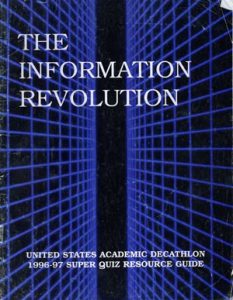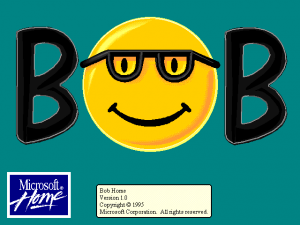It’s been 20 years since “The Information Revolution” graced the cover of the Academic Decathlon Super Quiz study guide. In homage, I thought I would take some time to reflect on the short essays that helped define the course of my career. This article will focus on the first, and one of my favorite of the essays, “Dos Miserables” by Paul Berman, first published in The New Yorker, April 3rd, 1995.

Berman argues that in the last millennium there have been two great paradigm shifts in mass-communication. The first occurred in the 15th century with the invention of the printing press by Johannes Gutenberg. At the time, communication was doled out to the majority of the population via the great cathedrals such as Notre-Dame. Stories were told not only by those who taught there, but by the architecture of the buildings themselves. Biblical tales were spelled out in single, massive stained glass windows. The reminders of light (saints and prophets) and darkness (gargoyles and grotesque creatures) in the world adorned the outer walls in sculpture. Even time was told for everyone by the bells that tolled in their great towers. Cathedrals truly were an “awesome engine of communication.”
The written word was by no means a new invention, but only the highly educated could read and write. Texts were limited, since scrolls and books were transcribed by hand. Gutenberg changed all of that with the printing press. Now, information, much more detailed and intricate than found in and on cathedrals, could fit on a desk instead of on a city block. It’s hard to argue the clear value of the book compared to the cathedral. Information could be provided, updated, expanded on much quicker and easier and cheaper than ever before. Yet in the years that followed the proliferation of the book, there remained generations of people loyal to the cathedral and its method of communication. “How silly” they must have called the book with its smelly pages and lack of architectural beauty. I bet they even argued, “it can’t even tell you the time!” Simply said, “..the triumph of the book over the cathedral [was] progress for civilization…but not necessarily progress for every individual person.” The transition from cathedral to book as a form of mass communication divided society into those that were ready and willing to embrace the change and those that resisted and ultimately that fell behind.
Over the last 30 years now we’ve been undergoing the second of Berman’s mass-communication paradigm shifts, spurred on by the microprocessor, computers and the internet. Much like the obvious gains of embedding information into the book, a smaller, more portable, more detailed medium, few can argue the gain in information accessibility, capability, and accuracy that computers can provide over the book. To soothe even the cathedral-loving, book naysayers, computers even tell the time! Just like the last information revolution though, the triumph of the PC over the printed type has once again divided the human race into those who flourish and prosper in the new technology and those who lapse into gloom and despair. “Computers require a sharply different set of aptitudes, and if the aptitudes are missing…misery is guaranteed, ” even if that class of people are splendidly educated, at least as measured by book reading.
So in the 500 years since the last communication shift, have we managed to learn anything to help bridge the gap between these two classes of people? How can the technology itself help bridge the gap? In 1995 when Berman published the article, Macintosh had been using a GUI interface with pictures of files and folders to help with computer navigation for about 10 years. Windows 95 was due to be released in all of its Rolling Stones “Start Me Up” pomp and circumstance. In the spring of 1995 Microsoft spectacularly failed to further bridge the gap with Microsoft Bob, an interface designed to help people understand the computer by correlating computer tasks with interactions around a virtual house. Fascinatingly enough, Bob’s failure was not because of what it was trying to achieve conceptually. Instead its hardware requirements and cost were both too high for the group that needed it the most, the book-people of the world that were still probably holding out on even getting a PC in the first place.

No, the bridge for the book folk to become computer folk did not come from a software program, but instead it has evolved in the 20 years since Berman wrote his piece for the New Yorker. As the PC has shrunk from a desktop machine with a huge CRT monitor, to a portable laptop, to now tablets and mobile phones, and the internet has sped up from 1200 baud modems to readily available hi-speed broadband, I believe the blending of familiar technology with new technology is the true bridge for forms of mass-communication. Almost a mini-paradigm shift, the creation of the smartphone and the blending of the new hotness of the PC wrapped up in an already accepted form of communication (the telephone) has forced upon the book people a reason to “give the gadgets a chance.” Smartphones and tablets and e-readers have further bridged the gap by providing interfaces for reading that look and feel like books and less like mouse clicking and certainly nothing like DOS prompts or command line interfaces.
Of course, smartphones and their associated dataplans are still out of reach for many around the globe. Access to technology is still limited for rural and depressed areas of the world. The cost of that same technology unquestionably is greater than that of a book (a few dollars) or visiting a cathedral (free). How the Information Revolution is potentially creating A New Divide Between Have and Have Nots (Time, 1995), however, will be the subject of another post.
It took many generations for the book to fully replace cathedrals as the centerpiece for mass communication in society. This was mainly due to how quickly the new technology could be distributed. The shift, as such, took many generations to complete. However, the paradigm shift brought on by the Information Revolution will be over in less than a century. Technology will continue to evolve at an ever increasing rate as devices become smaller, access becomes faster, and the breadth of knowledge and information available becomes wider. Those things that first made the Information Revolution so horrid from the beginning will never exist to those born today. Mouse balls will never get stolen from library computers, music will never get burned to CDs, the internet won’t be accessed through a modem and floppy disks will only exist in tech museums. What will be very different about this shift in mass communication is by its end, we won’t have some fancy thing to hold like when the book took the place of the cathedral, no, by the end of this shift, society will have learned how to adapt to constant change in the distribution of information until it is ubiquitous and we are “one with the data”. Much like the book people could never imagine a world with a computer though, we have no way to even remotely imagine what the next paradigm shift in mass-communication will be.



